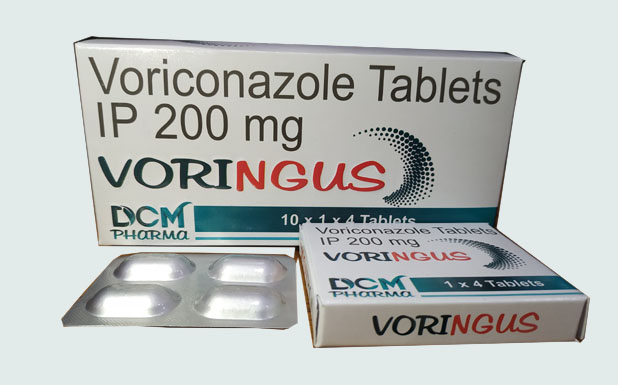
Composition
- Each Film Coated Tablet Contains:
- Voriconazole IP 200 mg
Packing
- 10X1X4
Alu-Alu
MRP
- 3,579
Overview
Voriconazole belongs to a group of drugs called triazole antifungal agents. These medicines are used to treat a wide variety of fungal infections. It works by killing or stopping the growth of the fungi that cause infections by blocking fungal cell wall growth, resulting in the death of the fungus. It can also be used to prevent fungal infections in people whose immune system is not working properly.
Compared with older azole drugs, ketoconazole, fluconazole, and itraconazole, voriconazole has a broader spectrum of antifungal activity, including Aspergillus species, endemic fungi, azole-resistant candida species, and a variety of other pathogenic opportunistic fungi such as Fusarium species, Pseudallescheria boydii, Scedosporium species, and dematiaceous fungi.
Indications
- It is used for the treatment of patients (adults and children over the age of 12) with:
- Invasive aspergillosis (a type of fungal infections due to Aspergillus species), including treatment of invasive aspergillosis in patients intolerant of, or whose disease is refractory to other antifungals.
- Candidaemia (another type of fungal infection due to Candida species) in non- neutropic patients (patients without abnormal low blood white cells count).
- Serious invasive Candida species infections when the fungus is resistant to fluconazole (another antifungal medicine).
- Serious fungal infections caused by Scedosporium species or Fusarium species (two different species of fungi).
- Voriconazole is intended for patients with worsening, possibly life-threatening, fungal infections.
- For HIV-infected adults and adolescents with invasive aspergillosis, voriconazole is recommended as the drug of choice.
Mechanism of action
The mechanism of action of voriconazole, similar to that of all azole agents, is inhibition of cytochrome P450 (CYP 450) – dependent 14a-lanosterol demethylation, which is a vital step in cell membrane ergosterol synthesis by fungi. For yeasts, voriconazole appears to be fungistatic, as are other azoles. However, for some filamentous organisms, voriconazole and other second-generation azoles are fungicidal. This effect may relate to the stronger avidity of the new azoles for the lanosterol 14a-demethylase found in molds, compared with that found in yeasts, which may allow more-complete interruption of ergosterol synthesis and lead to cell death.
Drug Interaction
- Decreases voriconazole levels: Carbamazepine, Long-acting Barbiturates, Rifampin.
- Levels increased by voriconazole: Astemizole, Cisapride, Cyclosporine, Ergot alkaloids, Omeprazole, Quinidine, Sirolimus, Tacrolimus, Terfinadine, Warfarin.
- Decreases voriconazole levels and increases other drug levels: Rifabutin, Phenytoin.
- Levels likely increased by voriconazole: Sulfonylureas, Statins, Vinca –alkaloids, Calcium channel blockers, Benzodiazepines.
Pharmacokinetics
Absorption: When administered either 1 h before or 1h after a meal, the bioavailability of the oral formulation is ˃ 90%. Gastric acid is not needed for absorption; fatty foods decrease bioavailability to ~ 80%. In adults, after oral administration of 200 mg twice daily, steady-state plasma concentrations generally range from 2 to 3 mg/mL. Patients who weigh ˃ 40 kg should receive 200 mg every 12 h, and those who weigh ˂ 40 kg should receive 100 mg every 12 h. Steady-state concentrations are achieved within 24 h if a loading dose twice the amount of the daily dosage is given on day 1. In adults, voriconazole exhibits nonlinear pharmacokinetics, which is thought to be related to saturation of metabolism. There is substantial intersubject variability in the serum concentrations achieved. In children, elimination is linear, and higher dosages are required to attain the serum concentrations noted in adults.
Distribution: Voriconazole is 58% protein bound and has a large volume of distribution. In animals and humans, concentrations in the CSF are ~ 50% of plasma concentrations; concentrations in brain tissue are higher than those in the CSF.
Metabolism: Metabolism of voriconazole occurs in the liver via the CYP450 enzyme family, including the CYP2C9, CYP3A4, and CYP2C19 isoenzymes. The metabolites do not have antifungal activity. The activity of the CYP2C19 pathway, which is the major metabolic pathway for voriconazole, is highly dependent on genetic characteristics.
Excretion: Less than 5% of the drug is excreted unchanged in the urine.
Side Effects
- More Common: Difficulty seeing at night, increased sensitivity of the eyes to sunlight, rash, vision changes.
- Less Common: Abdominal or stomach pain, bloating or swelling of the face, arms, hands, lower legs, or feet, clay-colored stools, confusion, dark urine, decreased urine, dizziness, dry mouth, fever, muscle pain or cramps, nausea, unusual tiredness or weakness.
Contraindication
- Drugs which are contraindicated: Carbamazepine, Long-acting Barbiturates, Rifampin, Astemizole, Cisapride, Ergot alkaloids, Quinidine, Sirolimus, Terfinadine, Rifabutin.
- Voriconazole is contraindicated in Pregnancy & Lactation.
- In Patients of known hypersensitivity to Voriconazole.